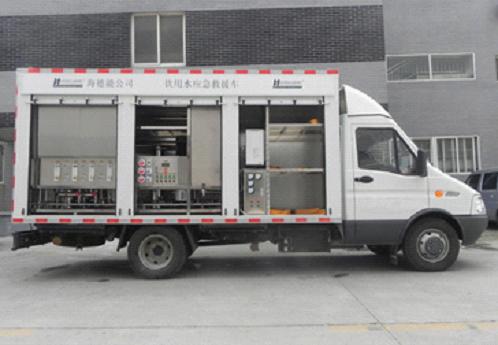The full name of the mobile water purification vehicle is the vehicle-mounted (mobile) water treatment equipment, which is specially applied to special vehicles that temporarily supply water in the event of natural disasters such as earthquakes or floods. It has the advantages of convenient operation, flexibility, and durability. The car is equipped with an independent water purification equipment, which is to turn the water from the big river, the groundwater, and the pond to the purified water that can be consumed by humans through the treatment of the water purification equipment. Developed using international advanced technology, everyone can drink with confidence. Water purification truck equipment and construction adopt international advanced membrane treatment technology and international advanced reverse osmosis water technology and UV C disinfection technology, etc., and the vehicle is equipped with a generator to provide power for the whole vehicle, as well as automatic control device protection. Safety control during water production. It is simple and convenient to operate, good mechanical properties, high degree of automation, superior purification, ability belongs to high-tech water supply equipment. Water is the fountain of life, especially in the rescue and relief process, the demand for water is even greater. How to filter, sterilize, and sterilize nearby sewage sources in a harsh environment and convert them into purified water for everyone to drink is a major challenge for water purification vehicles. The mobile water purification vehicle is a special vehicle that provides logistics and water supply protection for troops, relief workers, and victims. The function of the mobile water purification vehicle: The water purification equipment inside the vehicle can remove harmful microbial spores and bacteria, viruses in the sewage. Removes chemicals such as pesticides, pesticide residues, industrial solvents, and disinfectants from the water. Further remove heavy metals such as lead, arsenic, mercury, chromium, manganese, strontium, and uranium to prevent gastrointestinal diseases. Water pump water production is stable, not easy to plug, and the water quality is excellent. The mobile water purification truck is suitable for mobile water supply in remote and harsh areas such as remote areas. It is not afraid of bumpy roads and can withstand wind, sun and rain. Appropriate maintenance, maintenance, and replacement of parts can delay the life cycle of the car, reduce costs, and reduce material consumption. Sheet Metal Fabrication Service Definition of Sheet Metal Fabrication
• Galvanized steel
Sheet metal fabrication: Forming or Deformation
Advantages and Disadvantages of Sheet Metal Fabrication Sheet Metal Fabrication Service,Sheet Metal Fabrication Services,Cnc Sheet Metal Fabrication,Industrial Sheet Metal Fabrication Suzhou FCE precision electronics Co., LTD , https://www.fukeyifcesz.com
Sheet Metal fabrication is the creation of useful metallic parts and structures by the application of multiple fabrication processes. Sheet metal fabrication is basically a broad term that involves various complex processes like cutting, forming, bending, welding, machining, and assembling. The instructions include below: materials, processes, and tools required for sheet metal fabrication.
Types of Sheet Metal Fabrication Materials
The choice of metal depends on the final use of the fabricated parts.
Common fabrication processes:
• Carbon Steel
• Stainless Steel
• Aluminum
• Bronze
• Copper
• Brass
• Aluminized steel
Bending: Sheet metal bending is one of the most popular deformation processes. A machine known as a Press brake is used to bend sheet metals into V, U, or other complex shapes. With an increase in gauge thicknesses of sheet metals the force required to bend increases.
Stamping: In the stamping process, a hydraulic or mechanical stamping press equipped with a tool and die is used to perform specific tasks like curling, drawing, embossing, flanging, etc
Hemming: Hemming is a process by which the edges of sheet metal are folded over itself or another piece of sheet metal to create a rounded edge. In the sheet metal fabrication process, two types of hemming processes are widely involved. They are roll hemming and conventional die hemming. Conventional hemming is used for mass production. A hemming roller is used for roll hemming.
Spinning: Spinning is a metal fabrication process where a lathe machine is used to rotate the sheet metal against a tool to produce conical or cylindrical shapes.
As sheet metal fabrication covers a wide area of techniques and methods, the advantages and limitations will vary depending on the process used during fabrication.
Benefits:
i. Sheet metal fabrication is fast and can produce high-quality components.
i. A large number of processes are available with wide range of materials
ii. High strength to weight ratio for sheet metal fabricated parts.
Disadvantage:
i. Each fabrication process has their own limitations.
ii. High initial cost for set up of equipment and tools.
iii. Requirement of skilled labors for each process.